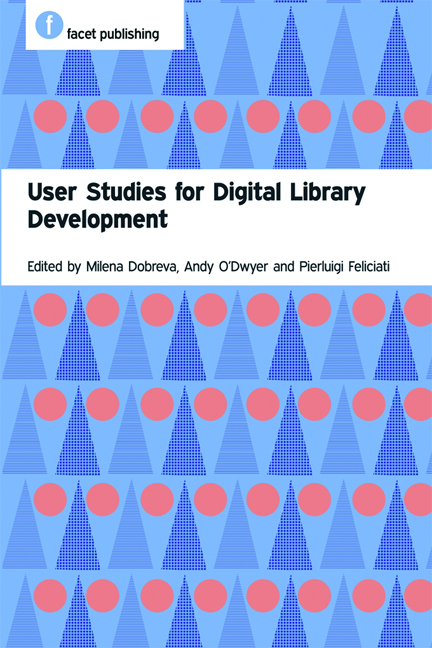Book contents
- Frontmatter
- Contents
- Preface
- Acknowledgements
- Abbreviations
- Glossary
- 1 Introduction: user studies for digital library development
- PART 1 SETTING THE SCENE
- PART 2 METHODS EXPLAINED AND ILLUSTRATED
- PART 3 USER STUDIES IN THE DIGITAL LIBRARY UNIVERSE: WHAT ELSE NEEDS TO BE CONSIDERED?
- PART 4 USER STUDIES ACROSS THE CULTURAL HERITAGE SECTOR
- 18 User studies in libraries
- 19 User studies in archives
- 20 User studies in museums: holding the museum in the palm of your hand
- 21 Digital art online: perspectives on user needs, access, documentation and retrieval
- 22 User studies for digital libraries’ development: audiovisual collections
- 23 A business-model perspective on end-users and open metadata
- PART 5 PUTTING IT ALL TOGETHER
- Index
22 - User studies for digital libraries’ development: audiovisual collections
from PART 4 - USER STUDIES ACROSS THE CULTURAL HERITAGE SECTOR
Published online by Cambridge University Press: 08 June 2018
- Frontmatter
- Contents
- Preface
- Acknowledgements
- Abbreviations
- Glossary
- 1 Introduction: user studies for digital library development
- PART 1 SETTING THE SCENE
- PART 2 METHODS EXPLAINED AND ILLUSTRATED
- PART 3 USER STUDIES IN THE DIGITAL LIBRARY UNIVERSE: WHAT ELSE NEEDS TO BE CONSIDERED?
- PART 4 USER STUDIES ACROSS THE CULTURAL HERITAGE SECTOR
- 18 User studies in libraries
- 19 User studies in archives
- 20 User studies in museums: holding the museum in the palm of your hand
- 21 Digital art online: perspectives on user needs, access, documentation and retrieval
- 22 User studies for digital libraries’ development: audiovisual collections
- 23 A business-model perspective on end-users and open metadata
- PART 5 PUTTING IT ALL TOGETHER
- Index
Summary
Introduction
Audiovisual media in the digital domain share many of the basic and fundamental user requirements of other types of collections, centred on a high degree of usability, focused around specific tasks and actions matched to different user groups. However, the delivery of and user interaction with audiovisual collections does have specific considerations that need to be addressed in order to provide and maintain user satisfaction. ‘Audiovisual’ can be an ambiguous term, as Ray Edmondson observes (Edmondson, 2004); in this chapter we are concerned with collections made up of sound and moving images, such as film and video. User groups for audiovisual collections have many different profiles: the case study in this chapter addresses access to audiovisual content specifically for the personal consumer, the educational sector and media professionals. These are three very distinct groups with separate needs and expectations that need to be catered for in order to ensure a good level of service acceptability. These user groups were the primary targets of a recent project exploring how best to cluster audiovisual material from a number of European archives and provide access over the internet. We illustrate how endusers’ needs have been addressed through a taskled approach and by using a requirementsdefinition process that comprised questionnaires, qualitative interviews and field evaluations.
The cost of providing audiovisual collections in digital Form
There is a push to put many audiovisual collections online, and evidence of the great interest of users in this type of material. One of the findings from recent international user testing of Europeana illustrates this:
Audiovisual content is not as well represented as other material, and users wanted more of it.
(Dobreva et al., 2010, 4)Various digitization initiatives have come from many quarters. One example is the cultural heritage sector, wishing to share content with the widest possible audience. Another is the commercial sector, where the internet has enabled the full range of providers of audiovisual services, from independent filmmakers through to multinational companies selling DVDs and music, to place both new and archive audiovisual material online. They have a common goal in their desire to reach a target audience, and modern search engines really can help to match providers of services with their intended audience – driven in many cases by the commercial ambition of search engine providers to match advertising around search queries directly to targeted audiences.
- Type
- Chapter
- Information
- User Studies for Digital Library Development , pp. 225 - 234Publisher: FacetPrint publication year: 2012



